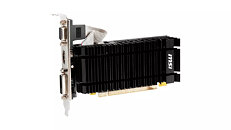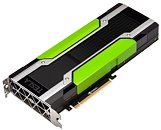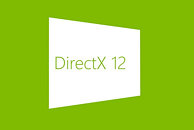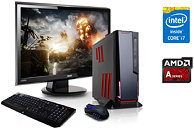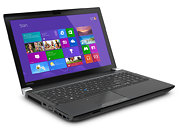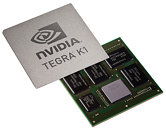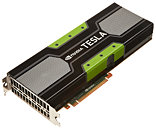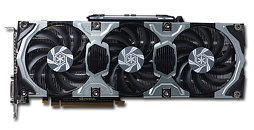Apr 10th, 2025 06:05 EDT
change timezone
Latest GPU Drivers
New Forum Posts
- Looking for input on fan placement for my Define R5 (4)
- How is the Gainward Phoenix Model in terms of quality? (2)
- Will you buy a RTX 5090? (478)
- Downgrading bios on asrock A320 board (1)
- Star Citizen (2515)
- ## [Golden Sample] RTX 5080 – 3300 MHz @ 1.020 V (Stock Curve) – Ultra-Stable & Efficient (45)
- RX 9000 series GPU Owners Club (276)
- random system shutdown with fans running at full speed (17)
- Shadow of the Tomb Raider benchmark (555)
- Do you use Linux? (573)
Popular Reviews
- The Last Of Us Part 2 Performance Benchmark Review - 30 GPUs Compared
- ASRock Z890 Taichi OCF Review
- MCHOSE L7 Pro Review
- Sapphire Radeon RX 9070 XT Pulse Review
- PowerColor Radeon RX 9070 Hellhound Review
- Upcoming Hardware Launches 2025 (Updated Apr 2025)
- Sapphire Radeon RX 9070 XT Nitro+ Review - Beating NVIDIA
- Acer Predator GM9000 2 TB Review
- ASUS GeForce RTX 5080 Astral OC Review
- UPERFECT UStation Delta Max Review - Two Screens In One
Controversial News Posts
- NVIDIA GeForce RTX 5060 Ti 16 GB SKU Likely Launching at $499, According to Supply Chain Leak (174)
- MSI Doesn't Plan Radeon RX 9000 Series GPUs, Skips AMD RDNA 4 Generation Entirely (146)
- Microsoft Introduces Copilot for Gaming (124)
- AMD Radeon RX 9070 XT Reportedly Outperforms RTX 5080 Through Undervolting (119)
- NVIDIA Reportedly Prepares GeForce RTX 5060 and RTX 5060 Ti Unveil Tomorrow (115)
- Nintendo Confirms That Switch 2 Joy-Cons Will Not Utilize Hall Effect Stick Technology (100)
- Over 200,000 Sold Radeon RX 9070 and RX 9070 XT GPUs? AMD Says No Number was Given (100)
- Nintendo Switch 2 Launches June 5 at $449.99 with New Hardware and Games (99)
News Posts matching #Kepler
Return to Keyword Browsing
FSR 4 Support Arriving Day One for All Current FSR 3.1 Game Titles According to Leak
AMD Radeon engineers are spending newly allocated extra time on optimizing their upcoming FidelityFX Super Resolution 4 (FSR 4) technology—industry watchdogs believe that a finalized version will launch alongside the initial lineup of RDNA 4 graphics card, now scheduled for release in March. Recently, David McAfee—Vice President and General Manager of Ryzen and Radeon products—revealed that his colleagues were working hard on maximizing performance and enabling "more FSR 4 titles." Insiders have started theorizing about how the current landscape of FSR 3.1-compatible games will translate with next-gen "AI-driven" upscaling techniques—several outlets believe that a freshly patched PC version of The Last of Us Part I is paving the way for eventual "easy" updates.
Kepler_L2—an almost endless fountain of Team Red-related insider knowledge—picked up on a past weekend VideoCardz report, and proceeded to add some extra tidbits via social media interaction. They started off by claiming that Team Red's: "RDNA 4 driver replaces FSR 3.1 DLL with FSR 4." When queried about the implication of said development, Kepler believes that all FSR 3.1 game titles will become ready to support FSR 4 on day one. The upgrade process—possibly achieved through a driver-level DLL swap—is reportedly quite easy to implement. According to the insider: "yeah, it should just work."
Kepler_L2—an almost endless fountain of Team Red-related insider knowledge—picked up on a past weekend VideoCardz report, and proceeded to add some extra tidbits via social media interaction. They started off by claiming that Team Red's: "RDNA 4 driver replaces FSR 3.1 DLL with FSR 4." When queried about the implication of said development, Kepler believes that all FSR 3.1 game titles will become ready to support FSR 4 on day one. The upgrade process—possibly achieved through a driver-level DLL swap—is reportedly quite easy to implement. According to the insider: "yeah, it should just work."
MAXSUN Dips Back into NVIDIA GT 730 GPU Pool
Recent MAXSUN activities have been very Intel Arc "Battlemage" B-series GPU-focused—most notably, a leaked design that leverages dual M.2 slots. Earlier today, ITHome reported on the fresh retail release of two sort-of-new MAXSUN graphics cards in China (on JD.com)—MS-GT730 PH 4 GB (¥359/~US$49) and MS-GT730 PH 2 GB (¥329/~US$45). These super low budget offerings signal a dip back into technologies of old: NVIDIA's GK208 "Kepler 2.0" GPU—of 2014 vintage. This is a curious choice, given that Team Green's "Kepler" GPU generation has not received new drivers since the release of R470 (back in 2021), and the last security update arrived with NVIDIA's 473.47 WHQL driver.
ITHome reckons that MAXSUN has simply recycled its existing MS-GT730 Heavy Hammer 4G and MS-GT730 Heavy Hammer 2G card designs for an early 2025 market launch—TechPowerUp's GPU database produces another very similar looking model: the GT 730 Transformers III 2G. The online publication reached out to MAXSUN's JD storefront customer service for comment on the apparent refresh of old products. ITHome discovered that the renamed reissues are a result of demands generated by "internal supply chain management." MAXSUN stated that its production batch have changed, and it: "emphasizes that the performance (of their new models) is consistent with the old version(s)."
ITHome reckons that MAXSUN has simply recycled its existing MS-GT730 Heavy Hammer 4G and MS-GT730 Heavy Hammer 2G card designs for an early 2025 market launch—TechPowerUp's GPU database produces another very similar looking model: the GT 730 Transformers III 2G. The online publication reached out to MAXSUN's JD storefront customer service for comment on the apparent refresh of old products. ITHome discovered that the renamed reissues are a result of demands generated by "internal supply chain management." MAXSUN stated that its production batch have changed, and it: "emphasizes that the performance (of their new models) is consistent with the old version(s)."

Nintendo Switch 2 to Feature NVIDIA Ampere GPU with DLSS
The rumors of Nintendo's next-generation Switch handheld gaming console have been piling up ever since the competition in the handheld console market got more intense. Since the release of the original Switch, Valve has released Steam Deck, ASUS made ROG Ally, and others are also exploring the market. However, the next-generation Nintendo Switch 2 is closer and closer, as we have information about the chipset that will power this device. Thanks to Kepler_L2 on Twitter/X, we have the codenames of the upcoming processors. The first generation Switch came with NVIDIA's Tegra X1 SoC built on a 20 nm node. However, later on, NVIDIA supplied Nintendo with a Tegra X1+ SoC made on a 16 nm node. There were no performance increases recorded, just improved power efficiency. Both of them used four Cortex-A57 and four Cortex-A53 cores with GM20B Maxwell GPUs.
For the Nintendo Switch 2, NVIDIA is said to utilize a customized variant of NVIDIA Jetson Orin SoC for automotive applications. The reference Orin SoC carries a codename T234, while this alleged adaptation has a T239 codename; the version is most likely optimized for power efficiency. The reference Orin design is a considerable uplift compared to the Tegra X1, as it boasts 12 Cortex-A78AE cores and LPDDR5 memory, along with Ampere GPU microarchitecture. Built on Samsung's 8 nm node, the efficiency would likely yield better battery life and position the second-generation Switch well among the now extended handheld gaming console market. However, including Ampere architecture would also bring technologies like DLSS, which would benefit the low-power SoC.
For the Nintendo Switch 2, NVIDIA is said to utilize a customized variant of NVIDIA Jetson Orin SoC for automotive applications. The reference Orin SoC carries a codename T234, while this alleged adaptation has a T239 codename; the version is most likely optimized for power efficiency. The reference Orin design is a considerable uplift compared to the Tegra X1, as it boasts 12 Cortex-A78AE cores and LPDDR5 memory, along with Ampere GPU microarchitecture. Built on Samsung's 8 nm node, the efficiency would likely yield better battery life and position the second-generation Switch well among the now extended handheld gaming console market. However, including Ampere architecture would also bring technologies like DLSS, which would benefit the low-power SoC.

AMD RDNA 3 GPUs to Support DisplayPort 2.0 UHBR 20 Standard
AMD's upcoming Radeon RX 7000 series of graphics cards based on the RDNA 3 architecture are supposed to feature next-generation protocols all over the board. Today, according to a patch committed to the Linux kernel, we have information about display output choices AMD will present to consumers in the upcoming products. According to a Twitter user @Kepler_L2, who discovered this patch, we know that AMD will bundle DisplayPort 2.0 technology with UHBR 20 transmission mode. The UHBR 20 standard can provide a maximum of 80 Gbps bi-directional bandwidth, representing the highest bandwidth in a display output connector currently available. With this technology, a sample RDNA 3 GPU could display 16K resolution with Display Stream Compression, 10K without compression, or two 8K HDR screens running at 120 Hz refresh rate. All of this will be handled by Display Controller Next (DCN) engine for media.
The availability of DisplayPort 2.0 capable monitors is a story of its own. VESA noted that they should come at the end of 2021; however, they got delayed due to the lack of devices supporting this output. Having AMD's RDNA 3 cards as the newest product to support these monitors, we would likely see the market adapt to demand and few available products as the transition to the latest standard is in the process.
The availability of DisplayPort 2.0 capable monitors is a story of its own. VESA noted that they should come at the end of 2021; however, they got delayed due to the lack of devices supporting this output. Having AMD's RDNA 3 cards as the newest product to support these monitors, we would likely see the market adapt to demand and few available products as the transition to the latest standard is in the process.

NVIDIA Releases Security Update 473.47 WHQL Driver for Kepler GPUs
Ten years ago, in 2012, NVIDIA introduced its Kepler series of graphics cards based on the TSMC 28 nm node. Architecture has been supported for quite a while now by NVIDIA's drivers, and the last series to carry support was the 470 driver class. Today, NVIDIA pushed a security update in the form of a 473.47 WHQL driver that brings fixes to various CVE vulnerabilities that can cause anything from issues that may lead to denial of service, information disclosure, or data tampering. This driver version has no fixed matters and doesn't bring any additional features except the fix for vulnerabilities. With CVEs rated from 4.1 to 8.5, NVIDIA has fixed major issues bugging Kepler GPU users. With a high risk for code execution, denial of service, escalation of privileges, information disclosure, and data tampering, the 473.47 WHQL driver is another step for supporting Kepler architecture until 2024, when NVIDIA plans to drop the support for this architecture. Supported cards are GT 600, GT 700, GTX 600, GTX 700, Titan, Titan Black, and Titan Z.
The updated drivers are available for installation on NVIDIA's website and for users of TechPowerUp's NVCleanstall software.
The updated drivers are available for installation on NVIDIA's website and for users of TechPowerUp's NVCleanstall software.

MSI Pledges to Solve Graphics Card Shortages Single-Handedly... Thanks to the GeForce GT 730?
This just goes to show exactly how starved the market is for graphics cards - that the puny GeForce GT 730, from seven years ago, is being relaunched by a graphics card company. MSI might be oddballing the market here, since we haven't seen any other brand offering this particular graphics card. Of course, this won't solve the gaming graphics card shortage - this is a product that's meant for users that don't have a GPU output on their CPU and need to have a discrete solution.
The GT730 may have been revived partly due to its usage of DDR3 VRAM instead of the now ubiquitous GDDR6 - the pricing pf which is bound to increase, as we've seen with current ridiculous levels of demand. The GT 730 packs 384 CUDA cores and features a 902 MHz boost clock and 2 GB of DDR3 memory operating at 1,600 MHz across a 64-bit memory interface. The GT 730 sips only 23 W of power, meaning that it doesn't need any power delivery outside that of the PCIe port - and aiding in the card's passive cooling. The fact that this is a Kepler card - and the fact that NVIDIA has announced end of support for Kepler cards with the release of the GeForce R470 drivers - should actually have no impact on its preferred usage on today's technology landscape.
The GT730 may have been revived partly due to its usage of DDR3 VRAM instead of the now ubiquitous GDDR6 - the pricing pf which is bound to increase, as we've seen with current ridiculous levels of demand. The GT 730 packs 384 CUDA cores and features a 902 MHz boost clock and 2 GB of DDR3 memory operating at 1,600 MHz across a 64-bit memory interface. The GT 730 sips only 23 W of power, meaning that it doesn't need any power delivery outside that of the PCIe port - and aiding in the card's passive cooling. The fact that this is a Kepler card - and the fact that NVIDIA has announced end of support for Kepler cards with the release of the GeForce R470 drivers - should actually have no impact on its preferred usage on today's technology landscape.

NVIDIA Enables GPU Passthrough for Virtual Machines on Consumer-Grade GeForce GPUs
Editor's note: This is not a part of April Fools.
NVIDIA has separated professional users and regular gamers with the company's graphics card offering. There is a GeForce lineup of GPUs, which represents a gaming-oriented version and its main task is to simply play games, display graphics, and run some basic CUDA accelerated software. However, what would happen if you were to start experimenting with your GPU? For example, if you are running Linux, and you want to spin a virtual machine with Windows on it for gaming, you could just use your integrated GPU as the GeForce card doesn't allow for virtual GPU passthrough. For these purposes, NVIDIA has its professional graphics card lineup like Quadro and Tesla.
However, this specific feature is about to arrive in even the GeForce lineup offerings. NVIDIA has announced that the company is finally bringing the basic virtual machine passthrough functions to the gaming GPUs. While the feature is representing a step in the right direction, it is still limited. For example, the GeForce GPU passthrough supports only one virtual machine and SR-IOV feature is still not supported on GeForce. "If you want to enable multiple virtual machines to have direct access to a single GPU or want the GPU to be able to assign virtual functions to multiple virtual machines, you will need to use NVIDIA Tesla, Quadro, or RTX enterprise GPUs.", says the NVIDIA FAQ. GeForce virtualization, which is now still in beta, is supported on R465 or higher drivers.The full content from NVIDIA's website is written below.
NVIDIA has separated professional users and regular gamers with the company's graphics card offering. There is a GeForce lineup of GPUs, which represents a gaming-oriented version and its main task is to simply play games, display graphics, and run some basic CUDA accelerated software. However, what would happen if you were to start experimenting with your GPU? For example, if you are running Linux, and you want to spin a virtual machine with Windows on it for gaming, you could just use your integrated GPU as the GeForce card doesn't allow for virtual GPU passthrough. For these purposes, NVIDIA has its professional graphics card lineup like Quadro and Tesla.
However, this specific feature is about to arrive in even the GeForce lineup offerings. NVIDIA has announced that the company is finally bringing the basic virtual machine passthrough functions to the gaming GPUs. While the feature is representing a step in the right direction, it is still limited. For example, the GeForce GPU passthrough supports only one virtual machine and SR-IOV feature is still not supported on GeForce. "If you want to enable multiple virtual machines to have direct access to a single GPU or want the GPU to be able to assign virtual functions to multiple virtual machines, you will need to use NVIDIA Tesla, Quadro, or RTX enterprise GPUs.", says the NVIDIA FAQ. GeForce virtualization, which is now still in beta, is supported on R465 or higher drivers.The full content from NVIDIA's website is written below.

NVIDIA Ceases Support for 3DVision, Mobile Kepler
NVIDIA via a customer help post has announced that their 3DVision work will be ceasing come April 2019. Release 418 of NVIDIA's GeForce Game Ready Drivers, and all other driver packages, will cease to provide support and improvements to 3DVision across the titles that are already covered by the technology. Users who want to keep 3DVision support will have to stay with the 418 release. Extended support for issues already present in the latest 3DVision release will still be granted support by NVIDIA until April 2020.
Like 3D TVs, mobile and desktop computers with 3D-capable screens have dwindled to almost zero in recent years, with the technology proving to be more of a novelty than an actual addition to users' computing experience. The NVIDIA support post also states that driver support for their Kepler-based graphics cards will cease as of April 2019. Desktop Kepler is still supported.
Like 3D TVs, mobile and desktop computers with 3D-capable screens have dwindled to almost zero in recent years, with the technology proving to be more of a novelty than an actual addition to users' computing experience. The NVIDIA support post also states that driver support for their Kepler-based graphics cards will cease as of April 2019. Desktop Kepler is still supported.
GALAX GeForce EX OC "White Gamer" Series: Epic Product Name Fail
While GALAX has introduced numerous solid graphics cards over the years, their product names are a bit of a mouthful, or in some cases just odd. The latest example being their EX OC "White Gamer" line, which, let's face it, is a tad off-putting to say the least. Of course we know that GALAX aren't racist, but you have to wonder how something like this happens. It probably comes down to marketing focusing too much on buzzwords, forgetting the context of said words in the process. In my humble opinion you can trace it back to the fact every company has to stick "Gaming" in every product name or on every box. In this case you would think the fact the product is a graphics card for gaming would be enough to get the point across.
It all started with MSI in 2013, when NVIDIA Kepler was all the rage. They released the "MSI GTX 780 Gaming", which was an amazing product, better than what most other graphics cards vendors had to offer. Competitors were surprised by the success of MSI's new cards and instead of searching into the reasons for their own products failures, their conclusion was that it must be the "Gaming" name, that drove the sales, so suddenly everybody started to fluff up their product names.
It all started with MSI in 2013, when NVIDIA Kepler was all the rage. They released the "MSI GTX 780 Gaming", which was an amazing product, better than what most other graphics cards vendors had to offer. Competitors were surprised by the success of MSI's new cards and instead of searching into the reasons for their own products failures, their conclusion was that it must be the "Gaming" name, that drove the sales, so suddenly everybody started to fluff up their product names.

NVIDIA Announces the GeForce 388.10 Hotfix Drivers for Wolfenstein II
NVIDIA today released the latest version of their GeForce driver suite which brings with it critical support fixes for machine Games' Wolfenstein II: The New Colossus. This hotfix is of particular interest for Kepler-based GPUs - and the users that deploy these for eye-candy and 3D acceleration purposes. NVIDIA is counting on launching a new Game Ready driver package in the beginning of next week, bringing the best, optimal experience to the title.
If not for its impressive graphics and the fact that it's a Wolfenstein game, this one should probably capture your attention due to the developers cutting off multiplayer entirely, so that nothing interfered with the development of the games' single-player experience. In a world of canned single-player games due to these not being easy to develop microtransactions and DLC packs for, Machine Games' approach is one that should elicit an approving nod - at least for story pundits (disclaimer: this editor is one of those). You can download this driver below.DOWNLOAD: NVIDIA GeForce 388.10 Hotfix Drivers for Wolfenstein II: The New Colossus
If not for its impressive graphics and the fact that it's a Wolfenstein game, this one should probably capture your attention due to the developers cutting off multiplayer entirely, so that nothing interfered with the development of the games' single-player experience. In a world of canned single-player games due to these not being easy to develop microtransactions and DLC packs for, Machine Games' approach is one that should elicit an approving nod - at least for story pundits (disclaimer: this editor is one of those). You can download this driver below.DOWNLOAD: NVIDIA GeForce 388.10 Hotfix Drivers for Wolfenstein II: The New Colossus

NVIDIA Tesla P100 Available on Google Cloud Platform
NVIDIA announced that its flagship GPGPU accelerator, the Tesla P100, will be available through Google Cloud Platform. The company's Tesla K80 accelerator will also be offered. The Google Cloud Platform allows customers to perform specific computing tasks at an infinitesimally lower cost than having to rent hardware in-situ or having to buy it; by offloading your computing tasks to offsite data-centers. IT professionals can build and deploy servers, HPC farms, or even supercomputers, of all shapes and sizes within hours of placing an order online with Google.
The Tesla P100 is a GPGPU with the most powerful GPU in existence - the NVIDIA GP100 "Pascal," featuring 3,584 CUDA cores, up to 16 GB of HBM2 memory, and NVLink high-bandwidth interconnect support. The other high-end GPU accelerators on offer by Google are the Tesla K80, based on a pair of GK210 "Kepler" GPUs, and the AMD FirePro S9300 X2, based on a pair of "Fiji" GPUs.
The Tesla P100 is a GPGPU with the most powerful GPU in existence - the NVIDIA GP100 "Pascal," featuring 3,584 CUDA cores, up to 16 GB of HBM2 memory, and NVLink high-bandwidth interconnect support. The other high-end GPU accelerators on offer by Google are the Tesla K80, based on a pair of GK210 "Kepler" GPUs, and the AMD FirePro S9300 X2, based on a pair of "Fiji" GPUs.

NVIDIA Talks Vulkan, Supports it on "Kepler" and "Maxwell" GPUs
NVIDIA talked Vulkan in its latest GeForce blog post, announcing that your GeForce GTX graphics card already supports the "industry forged" API. NVIDIA is offering Vulkan hardware-acceleration on its "Kepler" and "Maxwell" GPU architectures at this time, and on Windows 7 and above; PC Linux, and Android. NVIDIA is all praises for Vulkan's low-latency and high-efficiency pathways, which streamline the process of drawing graphics.
Vulkan makes its big mainstream debut with a major update to "The Talos Principle," by Croteam (the people behind the "Serious Sam" franchise). This update adds a Vulkan renderer to the game, and ships later today. NVIDIA has an driver ready with the Vulkan API, which you can download from here. Maintained by the Khronos Group, Vulkan is a successor to OpenGL, although it's built from the ground up, with a major chunk of its code being contributed by AMD, from its Mantle API.
Vulkan makes its big mainstream debut with a major update to "The Talos Principle," by Croteam (the people behind the "Serious Sam" franchise). This update adds a Vulkan renderer to the game, and ships later today. NVIDIA has an driver ready with the Vulkan API, which you can download from here. Maintained by the Khronos Group, Vulkan is a successor to OpenGL, although it's built from the ground up, with a major chunk of its code being contributed by AMD, from its Mantle API.

NVIDIA Releases the GeForce 353.62 WHQL Drivers for Windows 10
In the wake of Microsoft Windows 10 launch, NVIDIA released its latest GeForce driver targeted at the new OS, GeForce 353.62 WHQL. This driver offers full support for WDDM 2.0, and DirectX 12 (feature level 12_0) support for NVIDIA GPUs based on the "Maxwell" and "Kepler" architectures. NVIDIA plans to enable DirectX 12 support for older "Fermi" (GTX 400, GTX 500 series) GPUs later this year. The driver also adds SLI profiles for a handful new games such as Batman: Arkham Knight (which was previously removed), Killing Floor 2, and Total War: Arena.
DOWNLOAD: NVIDIA GeForce 353.62 WHQL for Windows 10
DOWNLOAD: NVIDIA GeForce 353.62 WHQL for Windows 10

NVIDIA Releases GeForce 353.06 WHQL Drivers
In the wake of its new high-end GPU launch, the GeForce GTX 980 Ti, NVIDIA released new GeForce 353.06 WHQL drivers. In addition to support for the new GPU, version 353.06 WHQL is Game Ready for "Heroes of the Storm," including an SLI profile and one-click optimization in GeForce Experience.
The R353 drivers bring a few new features to the table, including G-Sync support for windowed applications (could be useful in 'windowed-maximized' display-modes in certain games), a new feature called ULMB (ultra-low motion-blur), which arbitrarily decreases motion-blur drawn by applications (could help with excessive ghosting on LCDs with high response-times), and Dynamic Super Resolution (DSR) for notebook GPUs. The drivers also add a comprehensive game-optimization suite for GPUs based on the "Kepler" architecture, which should increase frame-rates across the board for GeForce GTX 600 and GTX 700 series.DOWNLOAD: NVIDIA GeForce 353.06 WHQL for Windows 8/7/Vista 64-bit | Windows 8/7/Vista 32-bit | Windows XP 32-bit | Windows XP 64-bit
The R353 drivers bring a few new features to the table, including G-Sync support for windowed applications (could be useful in 'windowed-maximized' display-modes in certain games), a new feature called ULMB (ultra-low motion-blur), which arbitrarily decreases motion-blur drawn by applications (could help with excessive ghosting on LCDs with high response-times), and Dynamic Super Resolution (DSR) for notebook GPUs. The drivers also add a comprehensive game-optimization suite for GPUs based on the "Kepler" architecture, which should increase frame-rates across the board for GeForce GTX 600 and GTX 700 series.DOWNLOAD: NVIDIA GeForce 353.06 WHQL for Windows 8/7/Vista 64-bit | Windows 8/7/Vista 32-bit | Windows XP 32-bit | Windows XP 64-bit

NVIDIA Launches First WHQL-signed Windows 10 GeForce Driver
NVIDIA announced the first WHQL-signed driver for Windows 10. GeForce 352.84 WHQL offers full compliance to WDDM 2.0 specification, and offers support for DirectX 12 (feature level 12_0) on supported GPUs (all chips based on the "Kepler" and "Maxwell" architectures). There are no games that take advantage of DirectX 12 right now, but NVIDIA suggested a few tech-demos you can toy with, such as Forza DX12 renderer, Fable Legends DX12 Game Demo, Witch Chapter 0 DX12 SLI_support, King of Wushu DX12, and the Unreal Engine Race DX12 demo. DirectX 12 is highly anticipated among game developers, as it provides a leap in performance due to the way it handles multi-CPU. For the first time, 3D graphics rendering can take advantage of any number of CPU cores you throw at them, allowing game developers to increase eye-candy and detail. DirectX 12 will debut with Windows 10, which launches this July.DOWNLOAD: GeForce 352.84 WHQL for Windows 10 Desktop GPUs | Notebook GPUs

NVIDIA Releases GeForce 352.63 Beta Driver for Windows 10
NVIDIA released GeForce 352.63 Beta, a driver it recommends for all your pre-release Windows 10 testing. Tailored for WDDM 2.0 and DirectX 12, these drivers cover GeForce GPUs based on "Maxwell" and "Kepler" architectures only (GTX 900 series, GTX 700 series, and GTX 600 series only). It's still a wide selection of GPUs, which NVIDIA already announced will support DirectX 12. Grab your drivers from the links below:DOWNLOAD: GeForce 352.63 Beta for Windows 10 64-bit: Desktop Discrete GPUs | Notebook Discrete GPUs

NVIDIA Rolls Out GeForce 344.48 WHQL Game Ready Driver
NVIDIA rolled out the GeForce 344.48 WHQL "Game Ready" drivers, timed to launch with Civilization: Beyond Earth, Elite: Dangerous, and Lords of the Fallen. These drivers enable Dynamic Super Resolution (DSR), which debuted on the "Maxwell" based GeForce GTX 900 series, on all older "Fermi" and "Kepler" based GeForce GTX 500, GTX 600, and GTX 700 series GPUs.DOWNLOAD: GeForce 344.48 WHQL for Windows 8/7/Vista 64-bit, Windows 8/7/Vista 32-bit, WIndows XP 32-bit, Windows XP 64-bit

NVIDIA Scoops Up Computex Tradeshow Awards for Tegra K1, GRID
For the sixth year running, NVIDIA (NASDAQ: NVDA) has clinched a Best Choice Award at Computex, picking up the honor for NVIDIA GRID technology, as well as a coveted "Golden Award" for the NVIDIA Tegra K1 mobile processor. NVIDIA's honors mark the longest Best Choice Award win-streak of any international Computex exhibitor. More than 475 technology products from nearly 200 vendors competed for this year's recognition.
Tegra K1 is a 192-core super chip, built on the NVIDIA Kepler architecture -- the world's most advanced and energy-efficient GPU. Tegra K1's 192 fully programmable CUDA cores deliver the most advanced mobile graphics and performance, and its compute capabilities open up many new applications and experiences in fields such as computer vision, advanced imaging, speech recognition and video editing.
Tegra K1 is a 192-core super chip, built on the NVIDIA Kepler architecture -- the world's most advanced and energy-efficient GPU. Tegra K1's 192 fully programmable CUDA cores deliver the most advanced mobile graphics and performance, and its compute capabilities open up many new applications and experiences in fields such as computer vision, advanced imaging, speech recognition and video editing.
CyberPowerPC Debuts Zeus Mini SFF Series With Eight Pre-Built Models
The next level of small form factor PC gaming has arrived when CyberPower Inc., a global manufacturer of custom gaming PCs, today unleashes its Zeus Mini desktop series. Each model, priced from $599-1479, is stuffed with enough AMD or Intel processing and graphics crunching power to rival any full-size desktop PC.
CYBERPOWERPC's new Zeus Mini is ready to tear into games that demand the most system resources. Customers can choose between three AMD's Kaveri A-series processor models (Zeus Mini-A), or five different 4th Generation Intel Core processor models (Zeus Mini-I) starting with a Core i5-4440 up to a screaming fast Core i7-4770K at 3.50GHz. All processors in the Zeus Mini series are mounted to a Mini ITX motherboard packed with the latest AMD and Intel chipset that deliver the latest technologies including 802.11ac wifi, PCI Express 3.0, and more. Both processor options include multi-core support and dual-channel DDR3 gaming performance with a minimum of 8 GBs memory that is expandable to 16 GBs.
CYBERPOWERPC's new Zeus Mini is ready to tear into games that demand the most system resources. Customers can choose between three AMD's Kaveri A-series processor models (Zeus Mini-A), or five different 4th Generation Intel Core processor models (Zeus Mini-I) starting with a Core i5-4440 up to a screaming fast Core i7-4770K at 3.50GHz. All processors in the Zeus Mini series are mounted to a Mini ITX motherboard packed with the latest AMD and Intel chipset that deliver the latest technologies including 802.11ac wifi, PCI Express 3.0, and more. Both processor options include multi-core support and dual-channel DDR3 gaming performance with a minimum of 8 GBs memory that is expandable to 16 GBs.

Toshiba Showcases World's First Ultra HD 4K Laptops
Toshiba's Digital Products Division (DPD), a division of Toshiba America Information Systems, Inc., is showcasing today the world's first laptops featuring Ultra HD 4K displays during CES 2014. The Tecra W50 mobile workstation is ideal for engineers and 3D designers and the Satellite P50t for professional photographers, graphic designers and 4K movie enthusiasts. Both laptops will be available for purchase in mid-2014.
"As a leader in Ultra HD, we are leveraging our 4K TV expertise to deliver a display capable of four times the resolution of Full HD to provide smoother images with astounding details," said Carl Pinto, vice president of marketing and engineering, Toshiba America Information Systems, Inc., Digital Products Division. "We have applied years of experience and engineering resources to bring Ultra HD 4K technology into our premium laptops for consumers and businesses so they can usher in the next generation of content creation and consumption."
"As a leader in Ultra HD, we are leveraging our 4K TV expertise to deliver a display capable of four times the resolution of Full HD to provide smoother images with astounding details," said Carl Pinto, vice president of marketing and engineering, Toshiba America Information Systems, Inc., Digital Products Division. "We have applied years of experience and engineering resources to bring Ultra HD 4K technology into our premium laptops for consumers and businesses so they can usher in the next generation of content creation and consumption."

NVIDIA Slides Supercomputing Technology Into the Car With Tegra K1
NVIDIA's new Tegra K1 mobile processor will help self-driving cars advance from the realm of research into the mass market with its automotive-grade version of the same GPU that powers the world's 10 most energy-efficient supercomputers. The first mobile processor to bring advanced computational capabilities to the car, the NVIDIA Tegra K1 runs a variety of auto applications that had previously not been possible with such low power consumption.
Tegra K1 features a quad-core CPU and a 192-core GPU using the NVIDIA Kepler architecture, the basis for NVIDIA's range of powerful GPUs -- including the processors that are used in the top 10 systems featured in the latest Green500 list of the world's most energy-efficient supercomputers. Tegra K1 will drive camera-based, advanced driver assistance systems (ADAS) -- such as pedestrian detection, blind-spot monitoring, lane-departure warning and street sign recognition -- and can also monitor driver alertness via a dashboard-mounted camera.
Tegra K1 features a quad-core CPU and a 192-core GPU using the NVIDIA Kepler architecture, the basis for NVIDIA's range of powerful GPUs -- including the processors that are used in the top 10 systems featured in the latest Green500 list of the world's most energy-efficient supercomputers. Tegra K1 will drive camera-based, advanced driver assistance systems (ADAS) -- such as pedestrian detection, blind-spot monitoring, lane-departure warning and street sign recognition -- and can also monitor driver alertness via a dashboard-mounted camera.

ASUS ESC4000 G2 Servers Support Tesla K40 GPU Accelerators
ASUS today announced that its world-leading ESC4000 G2 series server range now supports the next-generation NVIDIA Tesla K40 (Kepler) GPU accelerators.
ESC4000 G2 series ranks very highly in the world's high-performance computing (HPC) tables, claiming the number 59 spot in the November 2013 TOP500 - the definitive list of the world's most powerful commercially available computers. The ESC4000 G2-powered SANAM cluster put in an incredible performance to deliver total processing power of 532.6TFLOPS.
ESC4000 G2 series ranks very highly in the world's high-performance computing (HPC) tables, claiming the number 59 spot in the November 2013 TOP500 - the definitive list of the world's most powerful commercially available computers. The ESC4000 G2-powered SANAM cluster put in an incredible performance to deliver total processing power of 532.6TFLOPS.
Cray Adds NVIDIA Tesla K40 to Its Complete Line of Supercomputing Systems
Global supercomputer leader Cray Inc. today announced the Cray CS300 line of cluster supercomputers and the Cray XC30 supercomputers are now available with the NVIDIA Tesla K40 GPU accelerators. Designed to solve the most demanding supercomputing challenges, the NVIDIA Tesla K40 provides 40 percent higher peak performance than its predecessor, the Tesla K20X GPU.
"The addition of the NVIDIA K40 GPUs furthers our vision for Adaptive Supercomputing, which provides outstanding performance with a computing architecture that accommodates powerful CPUs and highly-advanced accelerators from leading technology companies like NVIDIA," said Barry Bolding, vice president of marketing at Cray. "We have proven that acceleration can be productive at high scalability with Cray systems such as 'Titan', 'Blue Waters', and most recently with the delivery of a Cray XC30 system at the Swiss National Supercomputing Centre (CSCS). Together with Cray's latest OpenACC 2.0 compiler, the new NVIDIA K40 GPUs can process larger datasets, reach higher levels of acceleration and provide more efficient compute performance, and we are pleased these features are now available to customers across our complete portfolio of supercomputing solutions."
"The addition of the NVIDIA K40 GPUs furthers our vision for Adaptive Supercomputing, which provides outstanding performance with a computing architecture that accommodates powerful CPUs and highly-advanced accelerators from leading technology companies like NVIDIA," said Barry Bolding, vice president of marketing at Cray. "We have proven that acceleration can be productive at high scalability with Cray systems such as 'Titan', 'Blue Waters', and most recently with the delivery of a Cray XC30 system at the Swiss National Supercomputing Centre (CSCS). Together with Cray's latest OpenACC 2.0 compiler, the new NVIDIA K40 GPUs can process larger datasets, reach higher levels of acceleration and provide more efficient compute performance, and we are pleased these features are now available to customers across our complete portfolio of supercomputing solutions."
Inno3D Announces Three GeForce GTX 780 Ti Cards
The Inno3D and iChill GeForce GTX 780 Ti is a step up from the previous GTX 780 powerhouse. The gaming performance is incredibly fast, smooth, and whisper-quiet while it's also extremely overclocked. It features a massively powerful NVIDIA Kepler GPU of 2880 cores - 20% more than the GTX 780. Plus, it comes with 3 GB of high-speed GDDR5 memory and NVIDIA GPU Boost 2.0 technology, giving you the performance capabilities you need to game at extreme settings.
The GTX 780 Ti is more than just fast and smooth. It's perfectly tuned to today's most advanced gaming technologies with features like GeForce Experience for one-click driver and settings optimization, plus NVIDIA PhysX and TXAA for smooth, sharp graphics.
The GTX 780 Ti is more than just fast and smooth. It's perfectly tuned to today's most advanced gaming technologies with features like GeForce Experience for one-click driver and settings optimization, plus NVIDIA PhysX and TXAA for smooth, sharp graphics.

Dell Announces the Precision M3800 Mobile Workstation
Dell today launched the thinnest and lightest 15-inch true mobile workstation, the Dell Precision M3800, to its family of the world's most powerful mobile workstations. Merging beautiful design in an ultra-thin form factor with workstation-class performance, Dell has delivered an uncompromising system for digital content creators and engineers looking for portability, power and stylish design to match their image and environment.
"Dell has a long history of delivering leading-edge performance workstations for customers in engineering and digital content creation," said Jon Peddie, President, Jon Peddie Research. "After seeing the new Dell Precision M3800 ultra-thin mobile workstation it's like falling in love all over again. It has everything I want in a power notebook including a super processor and GPU, high-resolution and big screen, light weight, lots of I/O, great speakers and camera. What's not to love? With the M3800, I no longer have to sacrifice performance for mobility and beautiful design."
"Dell has a long history of delivering leading-edge performance workstations for customers in engineering and digital content creation," said Jon Peddie, President, Jon Peddie Research. "After seeing the new Dell Precision M3800 ultra-thin mobile workstation it's like falling in love all over again. It has everything I want in a power notebook including a super processor and GPU, high-resolution and big screen, light weight, lots of I/O, great speakers and camera. What's not to love? With the M3800, I no longer have to sacrifice performance for mobility and beautiful design."
Apr 10th, 2025 06:05 EDT
change timezone
Latest GPU Drivers
New Forum Posts
- Looking for input on fan placement for my Define R5 (4)
- How is the Gainward Phoenix Model in terms of quality? (2)
- Will you buy a RTX 5090? (478)
- Downgrading bios on asrock A320 board (1)
- Star Citizen (2515)
- ## [Golden Sample] RTX 5080 – 3300 MHz @ 1.020 V (Stock Curve) – Ultra-Stable & Efficient (45)
- RX 9000 series GPU Owners Club (276)
- random system shutdown with fans running at full speed (17)
- Shadow of the Tomb Raider benchmark (555)
- Do you use Linux? (573)
Popular Reviews
- The Last Of Us Part 2 Performance Benchmark Review - 30 GPUs Compared
- ASRock Z890 Taichi OCF Review
- MCHOSE L7 Pro Review
- Sapphire Radeon RX 9070 XT Pulse Review
- PowerColor Radeon RX 9070 Hellhound Review
- Upcoming Hardware Launches 2025 (Updated Apr 2025)
- Sapphire Radeon RX 9070 XT Nitro+ Review - Beating NVIDIA
- Acer Predator GM9000 2 TB Review
- ASUS GeForce RTX 5080 Astral OC Review
- UPERFECT UStation Delta Max Review - Two Screens In One
Controversial News Posts
- NVIDIA GeForce RTX 5060 Ti 16 GB SKU Likely Launching at $499, According to Supply Chain Leak (174)
- MSI Doesn't Plan Radeon RX 9000 Series GPUs, Skips AMD RDNA 4 Generation Entirely (146)
- Microsoft Introduces Copilot for Gaming (124)
- AMD Radeon RX 9070 XT Reportedly Outperforms RTX 5080 Through Undervolting (119)
- NVIDIA Reportedly Prepares GeForce RTX 5060 and RTX 5060 Ti Unveil Tomorrow (115)
- Nintendo Confirms That Switch 2 Joy-Cons Will Not Utilize Hall Effect Stick Technology (100)
- Over 200,000 Sold Radeon RX 9070 and RX 9070 XT GPUs? AMD Says No Number was Given (100)
- Nintendo Switch 2 Launches June 5 at $449.99 with New Hardware and Games (99)











